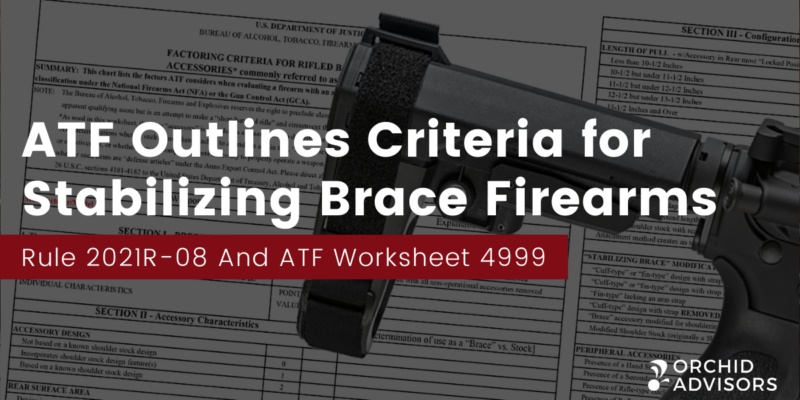On Monday, June 7, it was announced Attorney General Merrick B. Garland signed ATF proposed rule 2021R-08, “Factoring Criteria for Firearms with Attached ‘Stabilizing Braces.'” The news comes just one month after Garland signed rule 2021R-05 to amend the regulatory definitions of “frame or receiver.”
In summary, 2021R-08 amends regulations to clarify when a rifle is “intended to be fired from the shoulder,” outlining factors to be used by the ATF in determining whether firearms equipped with a “stabilizing brace” are a “rifle” or “short-barreled rifle” and thus an NFA “firearm.”
Definition of Rifle
As currently defined in 27 CFR 478.11 and 479.11, the term “rifle” includes language referring to a weapon’s intent “to be fired from the shoulder.” The new proposed ruling would amend and extend these definitions by adding a sentence to expand a “rifle” as any weapon with a rifled barrel and equipped “stabilizing brace” with certain design features and characteristics that indicate the firearm is designed to be fired from the shoulder.
These criteria are laid out in the new proposed ATF Worksheet 4999 — similar to ATF Form 4590, used in the importation of pistols and revolvers.
ATF Worksheet 4999
Titled “Factoring Criteria for Rifled Barrel Weapons with Accessories commonly referred to as ‘Stabilizing Braces,’” ATF Worksheet 4999 lists characteristics and features the ATF considers when evaluating firearm samples submitted with an attached “stabilizing brace” or similar component/accessory.
Factoring criteria is broken into three sections, ‘Prerequisites,’ ‘Accessory Characteristics’ and ‘Configuration of Weapon,” with Sections II and III using a point system to assign a weighted value to various characteristics. Point values range from 0 to 4 points based upon the degree of the indicator.
- 1 point (Minor Indicator): the weapon could be fired from the shoulder
- 2 points (Moderate Indicator): the weapon may be designed and intended to be fired from the shoulder
- 3 points (Strong Indicator): the weapon is likely designed and intended to be fired from the shoulder
- 4 points (Decisive Indicator): the weapon is designed and intended to be fired from the shoulder
Firearms scoring 4 points for more in both sections would be determined to have been designed and intended to be fired from the shoulder and thus classified as a “short-barreled rifle” and an NFA “firearm.” Firearms scoring less than 4 points in both sections would generally be determined not to have been designed to be fired from the shoulder (unless expressly intended to be fired from the shoulder by the manufacturer) and continued to be classified as a pistol with an attached “stabilizing brace.”
Section I: Prerequisites
Before a firearm is to be considered as a suitable weapon for a “stabilizing brace,” it must first meet specified weight and length requirements. To establish baselines, the ATF referenced common firearms, including the GLOCK 17 and CZ Scorpion EVO, stressing the importance of ease of handling, practicality and accuracy when fired one-handed.
Weapon Weight: Weapons must weigh at least 64 oz./4 lbs. with an unloaded magazine and no accessories
Overall Length: Weapons must have an overall length between 12”–26” with all non-operational accessories removed
Section II: Accessory Characteristics
If the submitted firearm meets both weight and length requirements, the attached “stabilizing brace” will be analyzed for characteristics of a shoulder stock, including its design, rear surface area, adjustability and stabilizing support.
Accessory Design: Evaluates if the “stabilizing brace” is or is not based on known shoulder stock design, or incorporates shoulder stock design features, such as adjustment levers, sling mounts and hardened surfaces.
Rear Surface Area: Evaluates if the “stabilizing brace” design features substantial rear surface area, further determining if device features prevent, discourage or encourage shouldering. “Fin type” accessories with minimal rear surface area would accrue 1 point.
Adjustability: Evaluates if the “stabilizing brace” features a fixed or telescoping design. While the ATF acknowledges adjustability, in and of itself, does not determine the design function of a “stabilizing brace” on a firearm, it remains a significant indicator of a device’s intent to be shouldered.
Stabilizing Support: Evaluates if the “stabilizing brace” design provides sufficient and stable forearm support. Referred to as a vital characteristic, devices are broken into three categories, Counterbalance, “Fin-type” and “Cuff-type,” each having its own scoring.
Section III: Configuration of Weapon
If a firearm proceeds, the entire weapon — with “stabilizing brace” and accessories added to affect firing — will be evaluated for effectiveness of single-handed firing, including length of pull, “stabilizing brace” attachment method and modifications/configuration, and peripheral accessories.
Length of Pull: Measured from the center of the trigger to the center of the “stabilizing brace” with the accessory in the most locked back position. A length of pull less than 10.5” will accrue zero (0) points, with points increasing each additional inch up to 13.5” or longer.
Attachment Method: Evaluates how the “stabilizing brace” is attached to the firearm. A standard AR-type pistol buffer tube (measuring 6”–6.5” long) accrues zero (0) points, while points are added for buffer tube adjustment notches, PDW-type guide rods, folding adaptors, spacers and more.
Device Modifications/Configuration: Evaluates if the “stabilizing brace” has been modified from its original configuration. Possible modifications include the lack of an arm strap, too short of an arm strap and adding shouldering surface to a “Fin-type” device.
Peripheral Accessories: Evaluates the presence of firearm accessories, including hand stops and secondary grips, rifle-type sights, sights/scopes with limited eye relief, and bipods/monopods, as well as weighs the weapon as configured with the “stabilizing brace,” accessories and an unloaded magazine. Complete firearms over 120 oz./7.5 lbs. are considered too heavy to be fired with one hand.
Affected Persons & Alternatives
With 3–7 million “stabilizing braces” sold between 2013–2020, the ATF estimates this ruling will affect more than 1.4 million individuals and 16,000 FFLs (Type 01 and 07), as well as at least eight “stabilizing brace” manufacturers.
The following actions are recommended to unlicensed possessors of firearms equipped with a “stabilizing brace”:
- Remove the “stabilizing brace”
- Remove the firearm’s short barrel and replace it with a barrel of 16” or longer
- Turn the firearm into a local ATF office
- Destroy the firearm
- Complete and submit a Form 1 to create a “short-barreled rifle”
The following actions are recommended to non-SOT FFLs and licensed manufacturers:
- Options 1–4 listed above
- Complete and submit a Form 1 (non-SOT FFLs) or Form 2 (licensed manufacturers)
However, the ATF has also outlined five proposed rule alternatives, including no change to the status quo, simplified criteria, grandfathering all existing firearms with “stabilizing braces,” and forgiving the $200 NFA Tax required when submitting a Form 1.
The comment period for 2021R-08 is currently open until September 8, 2021.
Orchid will continue monitoring the proposed rule changes and keep its clients and subscribers informed. Manufacturers and other FFL types are well-advised to prepare their business for the coming changes if the rule passes.







0 Comments